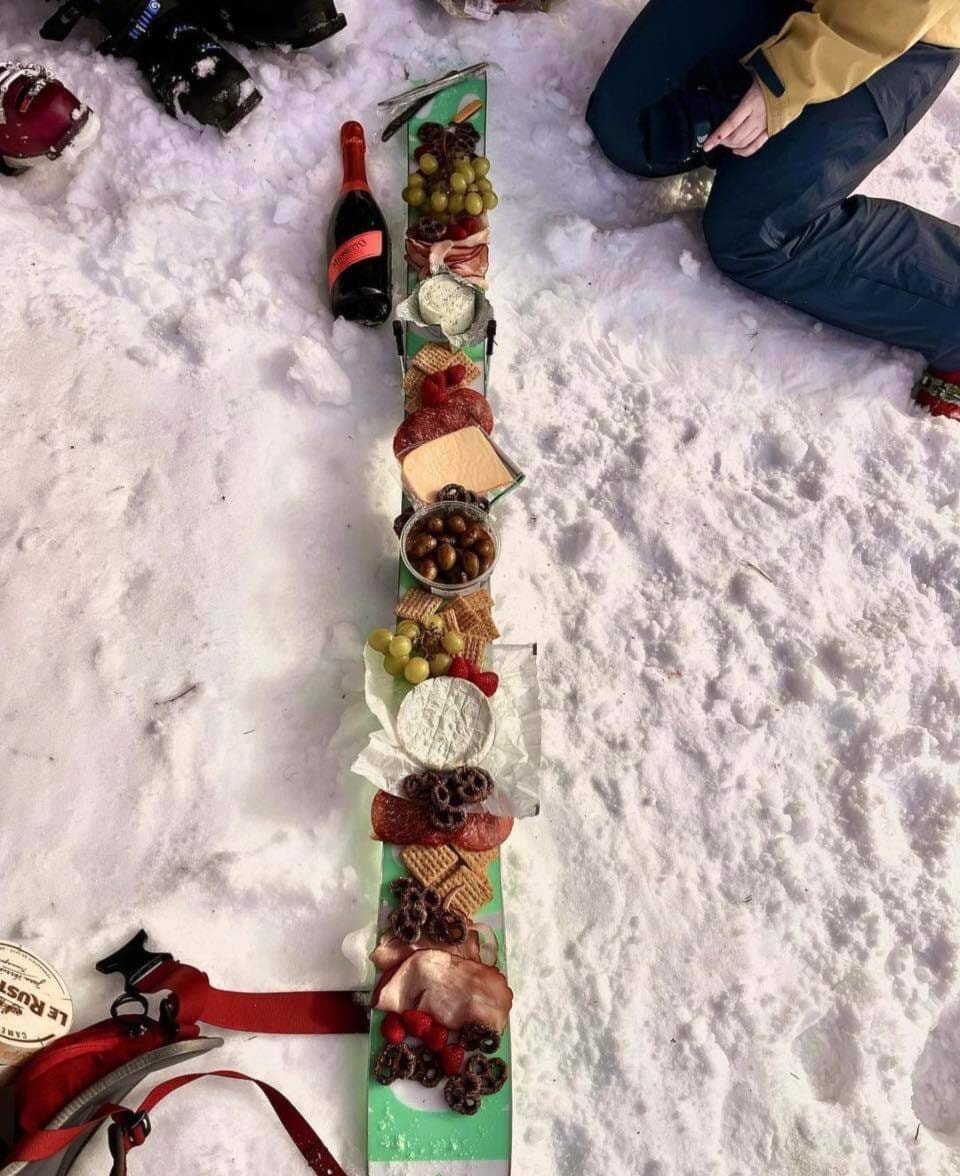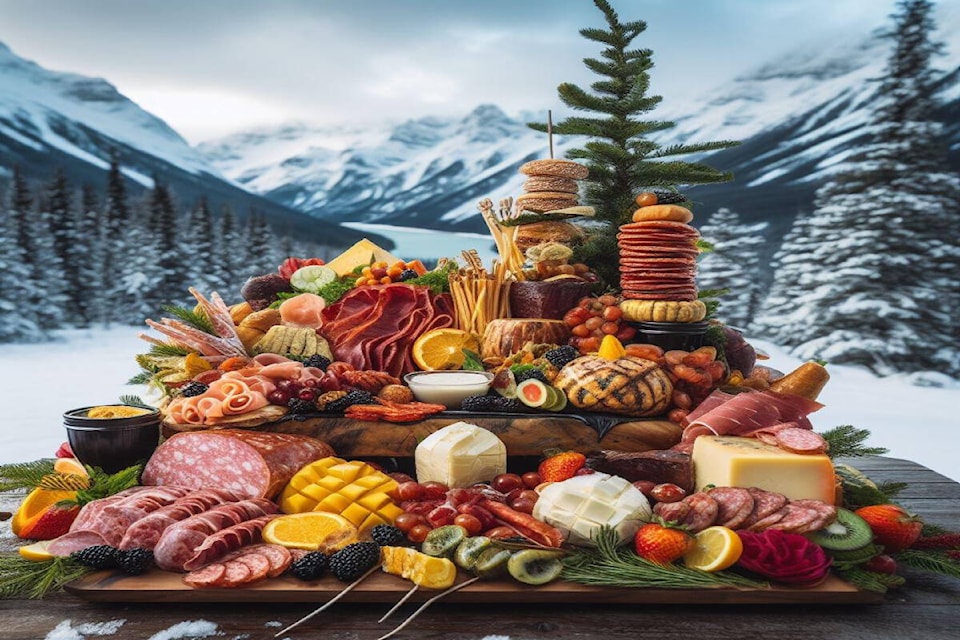This article appeared first in the winter edition of the Revelstoke TIMES magazine.
After impatiently awaiting it for months, now in late November watching as the snow sets in around the valley, the ski season is nearly upon us. Working hard in the off-season, many have sweated it out in the gym ensuring peak performance on the peaks. But was the same effort applied in the kitchen? Proper nutrition is key to taking on big terrain, but fuelling the body comes in all shapes and sizes.
I’ve interviewed scientists and ski touring professionals to get you the goods on backcountry nutrition. Read on to find out what food to bring into the backcountry and when to eat it so that you can enjoy every moment of those turns you’ve earned.
I caught up (if only for a moment) with Greg Hill, local super-athlete who has ski toured many millions of vertical feet throughout his impressive career and got his take on what to eat to maximize performance in the backcountry.
It turns out backcountry nutrition starts before you even leave town. Having a good meal the night before is key to setting the stage for physical activity.
Hill admitted his strategy is to eat a lot and to eat well, with a good balance of carbs, fats, and proteins, and as much natural food as possible. Hill recalled one lunch in Chile that he calculated to be over 4,000 calories in just one meal.
Similarly, you’ll want to stay hydrated in the time leading up to your backcountry trip, drinking lots of water the day before and the morning of. Electrolytes can come in handy too for some backcountry tourers out there, with many options on the market to take along during the day. You could even play the chemist and mix your own if you want to get technical – there are some good recipes available online.
Hill’s go-to breakfast on touring days is toast and eggs, or toast and peanut butter. For more fats that will help with slow-release energy, go heavy on the butter or think of adding avocados. Oatmeal is also a good option, with berries and high fat yogurt.
While out during the day, Hill opts for trail mix, jerky and oranges.
“I typically graze more than sit down and have a full-on lunch. I think grazing is the way to go,”he said.
This appears to be better for continuous energy supply and is easier on your system, which Dr. Paul Laursen confirmed.
Dr. Paul Laursen is a professor of exercise physiology and coach of elite athletes based here in Revelstoke.
While there isn’t a one-size-fits-all approach to nutrition because every body is different, the science points to a healthy diet for laying the best foundation for backcountry performance.
“You really want to try to predominantly fuel your body with whole food sources. Things that mother nature has provided for us,” Laursen said.

Whole foods help ensure a sustainable, slow-release, supply of glucose to the body.
Almonds, cheeses high in fat, and the classic peanut butter and jam or peanut butter and banana sandwich, are some of the foods that Laursen recommends for keeping energy high throughout the day. Beef jerky sticks can also be great for keeping protein and amino acid stocks balanced and avoiding sugar spikes.
While candy and gels have their place, these are best saved for the steepest pitches or the times when morale and spirits are low. Too big of a reliance on these fast sugars can lead to hyperglycemia, characterized by light-headedness and low energy.
“Ultimately what that sugar does is it doesn’t give you much metabolic fuel from an energetic standpoint, but it stimulates your central nervous system. Your body perceives from that sugar that there’s energy present and it revs up your nervous system. These sugars can’t be relied on for actual fuel. It’s more of an extra tool in the tool box that could get you through a really challenging sort of time,” Laursen said.
Coffee and other sources of caffeine, like tea, can also provide you with this central nervous system boost, as well as adding some warmth factor and increasing your mood. Laursen said that from a performance standpoint, these are alright as long as you don’t overdo it.
Other secret energetic weapons of ski-tourers are hard-boiled eggs and Laursen’s personal favourite: sardines.
“My friends all laugh at me because I bring sardines out with me. I love high quality sardines. They’re filled with protein and essential fatty acids and essential amino acids.”
Just be sure to wrap up the tin on the way out, and be thankful that all the bears are in hibernation.
Sardines or not, you’ve made it through your day in the backcountry and are looking for ways to refuel and rebuild after all that activity. If you’re headed back home and to civilization, a quick protein shake as soon as you get home can be a great way to begin to refuel. Ultimately, protein is very important at this stage for rebuilding and strengthening the muscles you’ve worked during the day. And as we’ve learned, balance is key here too, so rounding it out with some carbohydrates and fats, too.
If you’re staying and camping out in the backcountry, you can bring your own food to prepare, and dehydrating your own food can make for easy and practical meals when you’re out there. Additionally, the options for store-bought dehydrated meals are practically endless, and the ease of preparing them can be just what you need when you’re cold and weary after a day of touring.
Thankfully in Canada, regulations require these foods to display all the ingredients and nutrition information on the packet, so you know just how much protein and calories you’ll be taking in. Travers Fisk of Revy Outdoors was able to give me a bit more perspective on some products and what he eats while out touring.
“They’re pretty well-balanced. They’re high in protein and they have a decent amount of calories in them. The ones with the higher stats are usually getting that from whey protein and lactose, so they’re very dairy heavy. The ones that are more vegan or veggie conscious, you may have to eat more, but you’ll still feel really good,” said Fisk.
Fisk also mentioned having one or two of these as extras in your pack can be a lifesaver if things don’t go as planned and your day ends up being a lot longer than planned.
Fisk also discussed the best equipment for making dehydrated meals while in the backcountry
As far as stoves go, “if you’re doing high elevation, deep-winter, cold stuff, then liquid gas is usually your better fuel,” Fisk said. If you’re using the normal canister type fuels though, a pro tip is to immerse the canister part of the stove in water when you’re using it. The water being warmer than the outside air temperature can improve the efficiency of the stove.
Any article on backcountry ski-touring couldn’t be complete without a discussion on alcohol. A beer at the bottom of the slope or at the end of the day can be tantalizing, but is it really the right thing when it comes to ski performance?
The science on alcohol has become much clearer, with the new health Canada guidelines having come out in early 2023. However, there is speculation that the beer you have with your friends afterwards could even be lifesaving.
If your performance the next day is important, it could be best to steer clear of any more than one drink at the end of the day, according to Laursen.
“What it’s going to impair is your sleep. If your sleep quality is likely to be important for the next day, in terms of decision making and all of these things to get out of the wilderness, it isn’t the ideal post day fuel or nutrition.” Improper sleep can also negatively affect the breakdown of food and the body’s natural recovery systems, leaving you more likely to experience low energy levels.
Fisk suggested that the beer you share with your homies at the end of a long day touring could actually be the best thing you could do. This shared drink can facilitate the opportunity to recap the events and decisions of the day and make it easier to air any concerns among your fellows.
Your foundation of a healthy diet and locally sourced whole foods have propelled you through the day and you’re now sleeping soundly and dreaming of more spectacular turns to come. Now, the very last thing you have to nourish is the stoke. As evidenced by Greg Hill’s incredible backcountry exploits, this can be the key ingredient to really flourishing out in that winter wonderland.
“If you have the desire to get out there day after day, it’s the desire that you have to keep fueled more than your body, I think,” Hill said.
Whether it is body or mind, staying properly fuelled on a day out ski-touring is vital to both enjoyment and safety in the backcountry.
Contributed by Connor Arsenault
READ MORE:




